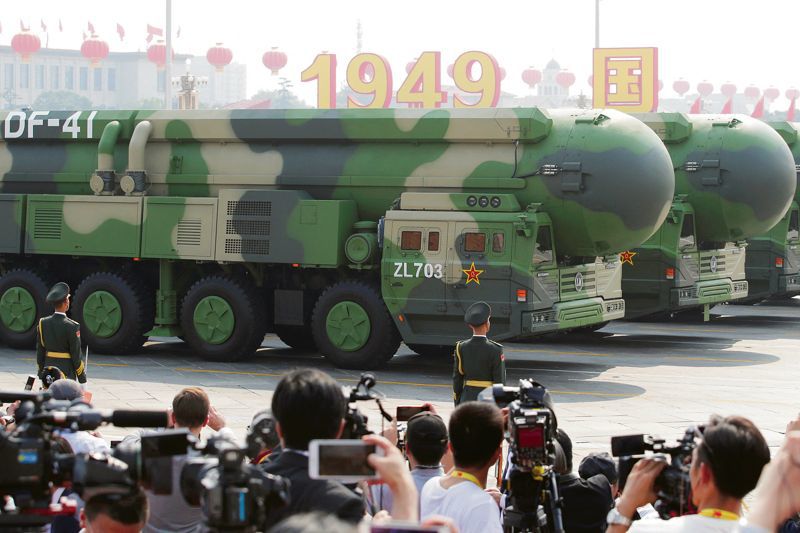No light at the end of the N-tunnel
THE apocalyptic nuclear weapons and a parlous global security framework were in focus this month, with two major reports being released on the same day (June 17) — one by the ICAN (International Campaign to Abolish Nuclear Weapons) and the second by SIPRI (Stockholm International Peace Research Institute). Their findings are both distressing and bleak.
A significant increase in the deployment of Chinese nukes would have significant implications for South Asian strategic stability.
The ICAN report reveals that the nine nuclear-weapon-capable nations (the US, UK, Russia, China, France, India, Israel, Pakistan and North Korea) collectively spent $91 billion last year in modernising and increasing their respective arsenals. Assuaging a deep-seated strategic insecurity syndrome apropos of the adversarial ‘other’ is the common thread for all nine nations.
Predictably, the top three spenders are the US with $51.5 billion, which is more than half of the global nuclear weapon-related spending in 2023, followed by China ($11.8 billion) and Russia ($8.3 billion). ICAN Director Melissa Parke noted that the nuclear powers collectively spent $2,898 per second last year on these weapons and that these funds exceed what the World Food Programme estimates as necessary to end world hunger. She added that “a million trees could be planted for each minute of spending on nuclear weapons”.
The reference to the number of trees that could be planted is particularly relevant in the context of the irreversible global warming and climate change exigency that the world responds to in an effete and indifferent manner. India, which is reeling under a scorching summer and a dangerously low people-tree ratio, is among the most affected among large nations (in terms of total area and demography). This geo-physical trend may soon prove to be the most serious threat to human security globally. The recent heatwave-related deaths during the Haj pilgrimage are illustrative.
The SIPRI Yearbook 2024 is a comprehensive volume that provides an overview of developments in international security, weapons and technology, military expenditure, arms production and the arms trade as well as armed conflicts and conflict management, along with efforts to control conventional, nuclear, chemical and biological weapons. The nuclear chapter of almost 100 pages is a valuable summary of recent developments and trends in the nuclear domain over the last year. Authors Hans Kristensen and Matt Korda are to be commended for their due diligence in furrowing a tenaciously opaque domain, where facts, information, disinformation and political rhetoric abound.
The key findings of the SIPRI nuclear survey are that the number and types of nuclear weapons in development have increased, as all nine nations deepen their reliance on nuclear deterrence to safeguard what they perceive as their core national interest. The most recent example is that of the Russia-Ukraine war, where Moscow has rattled its nuclear sabre to warn the US-led NATO about redlines, and in response, both NATO and the US have stated that they will enhance their nuclear readiness across the board.
The SIPRI nuclear overview indicates that in early 2024, the nuclear nine (N9) “possessed approximately 12,121 nuclear weapons, of which 9,585 were considered to be potentially operationally available. An estimated 3,904 of these warheads were deployed with operational forces, including about 2,100 that were kept in a state of high operational alert — about 100 more than the previous year.”
While the US and Russia still account for 88 per cent of the total global arsenal, an instructive statistic has been highlighted by SIPRI in relation to China, whose nuclear arsenal “has increased significantly from 410 warheads in January 2023 to 500 by January 2024, with expectations of continued growth”. It adds that China is in the middle of a significant modernisation and expansion of its nuclear arsenal over the next decade and “some projections suggest that China could potentially deploy at least as many intercontinental ballistic missiles as either Russia or the US in that period”.
While China may be pitting itself against the US, a visible increase in the deployment of Chinese nukes (from the current 24) would have significant implications for South Asian strategic stability that would be of grave import to New Delhi.
During the Cold War, the nuclear missile contest was played out between the US and its allies (UK and France) and the then USSR from 1945 to 1991. After the ‘scare’ of the 1962 Cuban missile crisis, both sides warily moved towards a degree of credible, robust nuclear deterrence that was predicated on arms control agreements and MAD (mutually assured destruction). This geopolitical, steady-state plateau had an ironic anomaly, wherein a deep techno-strategic insecurity was assuaged by accepting MAD — and the acronym captures the apocalyptic sardonicism.
Since the Russian invasion of Ukraine in February 2022, the world has been getting divided into two competing nuclear weapon clusters: the US-led military alliance (with the UK and France) versus the Russia-China dyad having North Korea as a junior partner. The other three members of N9 — India, Pakistan and Israel — have not formally joined either cluster, though their geopolitical orientation is self-evident.
The bleakness referred to at the outset stems from the fact that since 2022, the world has drifted from reasonably robust deterrence to one of fragile fecklessness. The earlier strategic communication among the major powers and well-entrenched arms control and restraint agreements have steadily frayed.
The US is going through an intense domestic socio-political churn with the possibility of a second Trump presidency. Russia remains determined to prosecute its war in Ukraine, come what may, while Chinese belligerence over its territorial claims continues to be brittle.
This is a bleak augury. The ICAN and SIPRI reports illuminate this arid landscape in an objective manner but underscore the grim reality that there is no light at the end of this tunnel.









